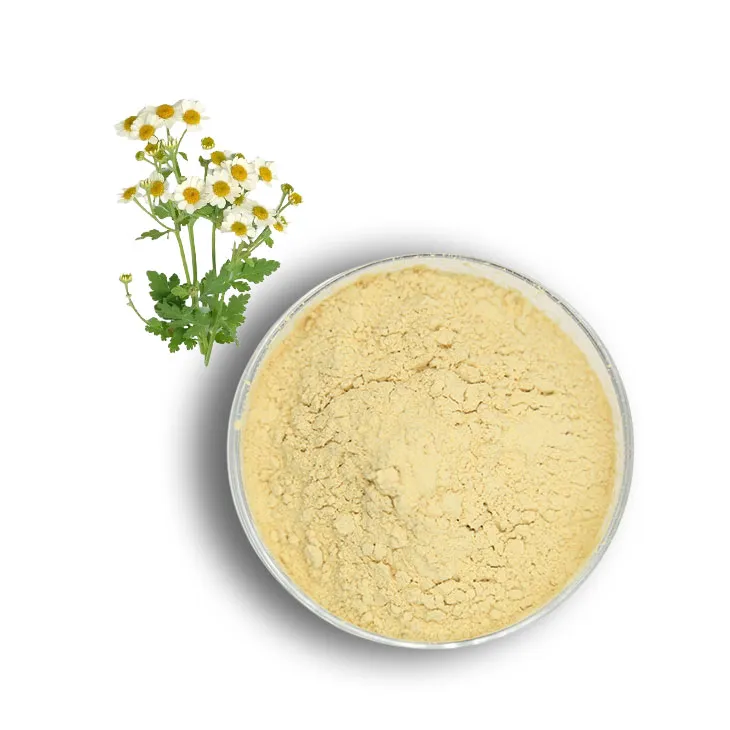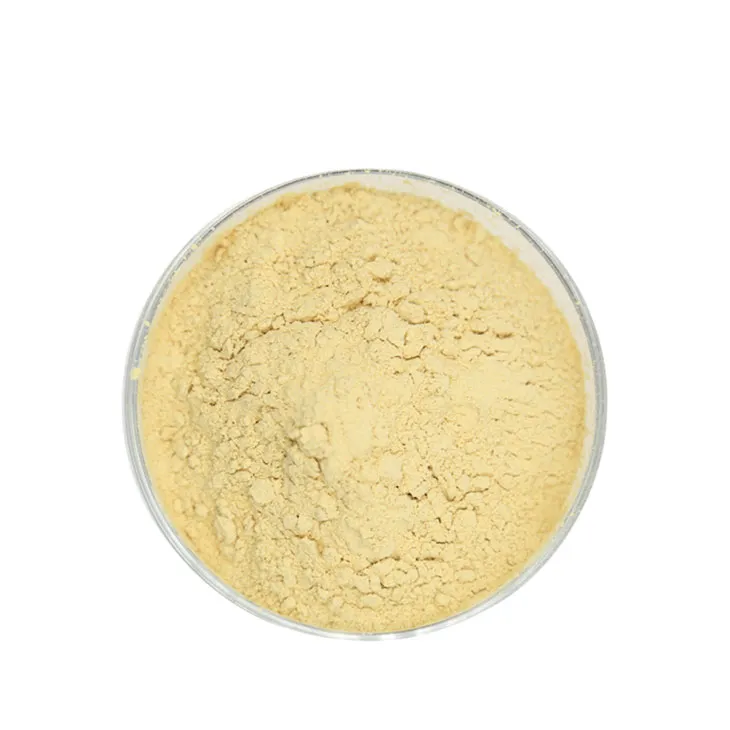- 0086-571-85302990
- sales@greenskybio.com
A Complete Guide to the Grinding Process of Feverfew Extract: Step - by - Step Key Points
2024-12-20

Introduction
White chrysanthemum, also known as feverfew, has been used in traditional medicine for centuries. Extracts from white chrysanthemum are rich in various bioactive compounds, which have potential health benefits. The grinding process is a crucial step in the production of white chrysanthemum extract. This guide will take you through the in - depth grinding process, covering techniques, precautions, and how to achieve the best results.

1. Raw Material Preparation
1.1 Selection of White Chrysanthemum
When choosing white chrysanthemums for extraction, it is essential to select high - quality flowers. Freshness is a key factor. Look for flowers that are in full bloom and free from diseases and pests. The origin of the chrysanthemums also matters. Those grown in clean and unpolluted environments are preferred.
1.2 Cleaning
Once the appropriate white chrysanthemums are selected, they need to be thoroughly cleaned. Remove any dirt, debris, or damaged parts. This can be done by gently rinsing the flowers under running water. Make sure not to soak them for too long, as excessive water absorption may affect the quality of the extract.
1.3 Drying
After cleaning, the white chrysanthemums should be dried. There are several drying methods available. Air - drying is a common and natural method. Spread the flowers in a well - ventilated area, away from direct sunlight. Another option is low - temperature drying, which can be done using a drying machine set at a low temperature (usually around 30 - 40°C). Drying helps to reduce the moisture content in the flowers, which is important for the subsequent grinding process.

2. Grinding Equipment Selection
2.1 Mortar and Pestle
For small - scale grinding, a mortar and pestle can be a good choice. It is a traditional grinding tool that allows for a more manual and controlled grinding process. However, it is relatively time - consuming and may not be suitable for large - quantity production.
2.2 Electric Grinders
Electric grinders are more efficient for larger - scale grinding. There are different types of electric grinders available, such as blade grinders and burr grinders. Blade grinders are generally more affordable but may not produce as fine a grind as burr grinders. Burr grinders, on the other hand, can provide a more consistent and fine grind, which is often preferred for herbal extract production.

3. Grinding Process
3.1 Coarse Grinding
Begin the grinding process with a coarse grind. If using a mortar and pestle, place a small amount of dried white chrysanthemums in the mortar and start grinding gently. For electric grinders, set the grinder to a coarse setting. This initial coarse grinding helps to break down the larger parts of the flowers into smaller pieces, making it easier for further grinding.
3.2 Fine Grinding
After the coarse grinding, move on to the fine grinding. In a mortar and pestle, continue grinding with more force and for a longer period to achieve a finer texture. For electric grinders, adjust the setting to a finer mode. The goal of fine grinding is to turn the white chrysanthemum into a fine powder as much as possible. This increases the surface area of the material, which is beneficial for the extraction of bioactive compounds.

4. Precautions during Grinding
4.1 Temperature Control
During grinding, especially with electric grinders, temperature control is crucial. High temperatures can cause the degradation of bioactive compounds in white chrysanthemum. If using a blade grinder, short grinding intervals should be used to prevent overheating. For burr grinders, make sure the grinder is properly cooled if it is used continuously.
4.2 Avoiding Contamination
Keep the grinding equipment clean to avoid contamination. Before and after use, clean the mortar and pestle or the electric grinder thoroughly. Use clean utensils to transfer the white chrysanthemum. Any foreign substances in the ground powder can affect the quality and purity of the extract.
4.3 Grinding Quantity
Do not overload the grinding equipment. For mortar and pestle, overloading can make it difficult to grind effectively. For electric grinders, overloading may lead to uneven grinding and potential damage to the equipment. Grind in appropriate quantities according to the capacity of the equipment.

5. Quality Control after Grinding
5.1 Particle Size Analysis
Check the particle size of the ground white chrysanthemum powder. This can be done using a sieve or other particle size analysis instruments. The desired particle size may vary depending on the extraction method, but generally, a finer powder is more suitable for efficient extraction.
5.2 Purity Check
Inspect the powder for any signs of contamination or impurities. This can be visually or through laboratory tests. Ensure that the powder contains only white chrysanthemum and no other unwanted substances.
6. Storage of Ground White Chrysanthemum Powder
6.1 Packaging
Transfer the ground white chrysanthemum powder to an appropriate packaging material. Airtight containers are preferred to prevent moisture absorption and contamination. Dark - colored containers can also be used to protect the powder from light, as some bioactive compounds may be sensitive to light.
6.2 Storage Conditions
Store the packaged powder in a cool, dry, and well - ventilated place. Avoid storing it near sources of heat or moisture. The ideal storage temperature is around 10 - 20°C. Proper storage helps to maintain the quality of the powder until it is used for extraction.
Conclusion
The grinding process of white chrysanthemum extract is a complex but important step in herbal extract production. By following the steps and precautions outlined in this guide, one can achieve high - quality ground white chrysanthemum powder, which is essential for obtaining a good - quality extract with maximum bioactive compounds. Whether for small - scale home use or large - scale commercial production, attention to detail in the grinding process is key.
FAQ:
Q1: What are the initial preparations for grinding Feverfew Extract?
Before starting the grinding process of Feverfew Extract, it is necessary to ensure that the feverfew is properly dried. This helps in achieving a more efficient grinding process. Also, the equipment used for grinding should be clean, dry, and in good working condition. High - quality grinding tools, such as a mortar and pestle or a suitable mechanical grinder, need to be selected based on the scale of production.
Q2: How fine should the feverfew be ground?
The fineness of the ground feverfew depends on the intended use of the extract. For most herbal extract production, a fine powder is desirable. Generally, aiming for a particle size that is as small as possible without causing excessive heat generation during grinding, which could potentially degrade the active compounds in the feverfew. A powder with a particle size in the range of 50 - 200 micrometers is often considered suitable for efficient extraction.
Q3: What precautions should be taken during the grinding process?
During the grinding of Feverfew Extract, it is crucial to avoid over - grinding, which can lead to the generation of excessive heat and may damage the active ingredients. Also, if using a mechanical grinder, it should be operated at the appropriate speed. Additionally, to prevent contamination, it is necessary to keep the grinding area clean and free from other substances. If possible, grinding should be carried out in a low - humidity environment to prevent moisture absorption by the feverfew powder.
Q4: Can the grinding method affect the quality of the feverfew extract?
Yes, the grinding method can significantly affect the quality of the feverfew extract. Different grinding methods can result in different particle sizes and surface areas of the ground material. A more uniform and fine grinding can increase the surface area available for extraction, potentially leading to a higher yield and better quality of the extract. However, improper grinding methods, such as those that generate excessive heat or cause mechanical damage to the plant material, can reduce the quality of the extract by degrading the active compounds.
Q5: How to store the ground feverfew powder?
The ground feverfew powder should be stored in an airtight container. It is best to store it in a cool, dry, and dark place. This helps to prevent moisture absorption, oxidation, and degradation of the active compounds. If stored properly, the powder can maintain its quality for a longer period, ensuring better results when used for extract production.
Related literature
- Advances in Herbal Extract Processing Techniques"
- "The Impact of Grinding on the Quality of Herbal Extracts"
- "Optimizing the Grinding Process for Medicinal Plant Extracts"
- ▶ Hesperidin
- ▶ citrus bioflavonoids
- ▶ plant extract
- ▶ lycopene
- ▶ Diosmin
- ▶ Grape seed extract
- ▶ Sea buckthorn Juice Powder
- ▶ Beetroot powder
- ▶ Hops Extract
- ▶ Artichoke Extract
- ▶ Reishi mushroom extract
- ▶ Astaxanthin
- ▶ Green Tea Extract
- ▶ Curcumin Extract
- ▶ Horse Chestnut Extract
- ▶ Other Problems
- ▶ Boswellia Serrata Extract
- ▶ Resveratrol Extract
- ▶ Marigold Extract
- ▶ Grape Leaf Extract
- ▶ blog3
- ▶ blog4
- ▶ blog5
-
Pure 85% Tomentil Extract.
2024-12-20
-
Soy Extract
2024-12-20
-
Passionflower Extract
2024-12-20
-
Plantain extract
2024-12-20
-
Kupilu Extract
2024-12-20
-
Hesperidin
2024-12-20
-
Honeysuckle Pollen
2024-12-20
-
Elderberry Extract
2024-12-20
-
Lemon Balm Extract
2024-12-20
-
Alisma Extract
2024-12-20
-
Shikone Extract
2024-12-20





















